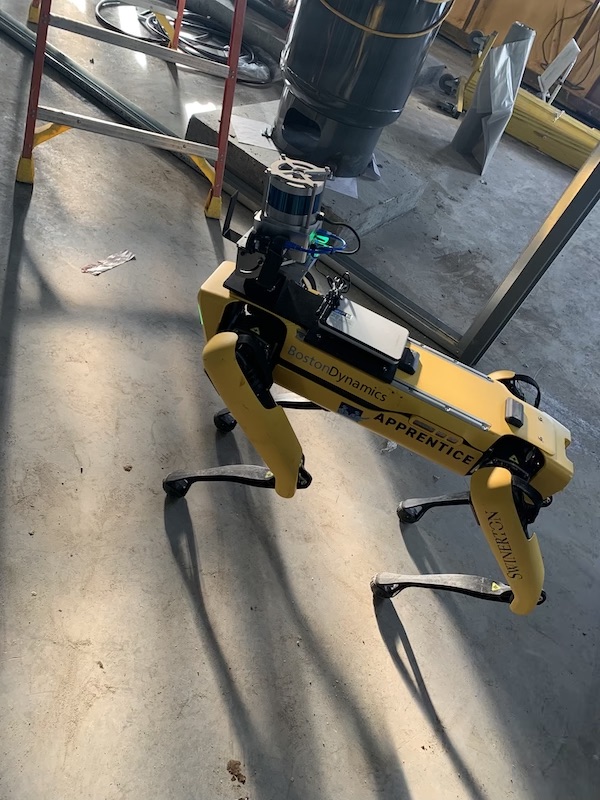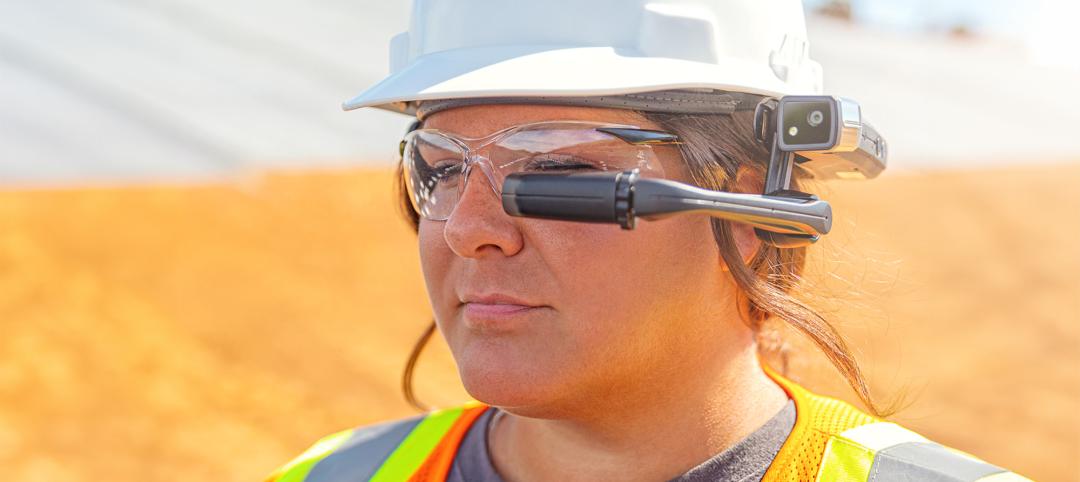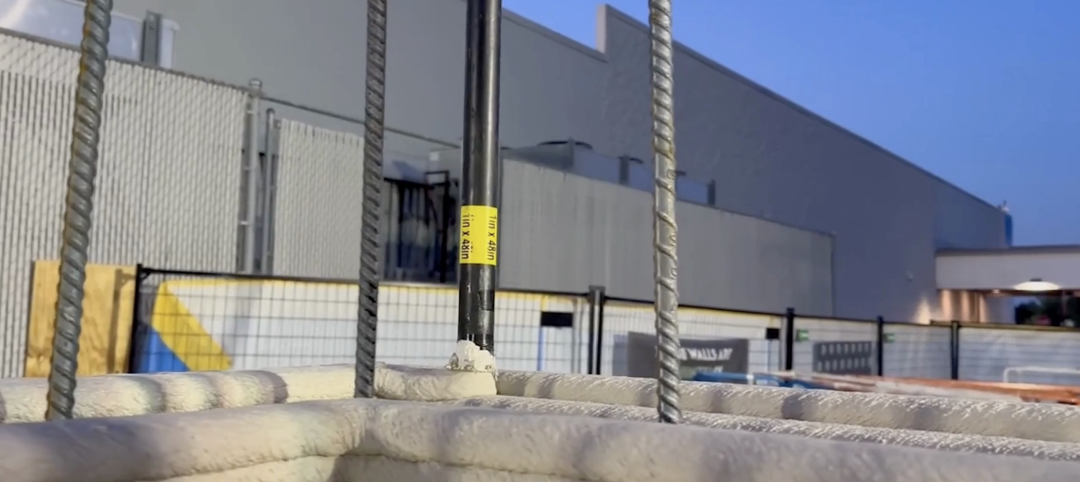Swinerton, the national construction services provider, is among the GCs that are embracing construction technology is various ways.
It is using high-definition 3D scanning technology to provide clients with such benefits as time-stamping work with preserved historical data, minimizing client travel thanks to remote walk-through capabilities, and coordinating subcontractors with an eye toward minimizing change orders and errors.
The firm’s prefab and modular construction capabilities leverage technology to reduce construction costs by as much as 20% per project, improve quality and safety, and expedite a project’s completion.
And on a number of its jobsites, Swinerton has been testing Boston Dynamics’ quadruped robot, better known as Spot Dog, for walk-throughs to inspect progress (such as tracking the numbers of studs or electrical conduit installed daily), measure and report data points, create a digital twin, and compare as-built to BIM.
Meet Spot Dog: The robotic inspection dog for construction jobsites
The three-foot-tall yellow robot “is an incredibly capable machine,” says Eric Law, Swinerton’s senior director of technology and innovation, whom BD+C interviewed last week with Tristen Magallanes, the firm’s innovation analyst; and Brian Ringley, a construction technology manager with Boston Dynamics.
Swinerton has been testing Spot Dog for four months. It used the robot to track the interior work within a ground-up medical office building in Redwood City, Calif. (That robot has since been relocated to one of Swinerton’s other projects in Austin, Texas.) The robot was also at work at the Queen Emma Building in Honolulu, Hawaii, where Swinerton is reconstructing an office building to affordable apartments.
The robot in use in Honolulu, which can handle a payload of up to 30 lbs., was equipped with a laser scanner and 360-degree camera. The robot, explains Ringley, can be controlled directly or tele-operated from offsite. There’s also an “auto-walk” feature where the user takes the robot to where he or she wants it to go, and artificial intelligence lets the robot repeats that pattern and tasks.
A video of Spot Dog in action in Honolulu can be viewed here.

Spot Dog, standing in front of Swinerton's brand image.
Law notes that a robot is better suited for capturing repetitive data because humans “have a hard time walking the same path everyday.” Spot Dog is also capable of navigating uneven terrain, and can be programmed to avoid obstacles.
Boston Dynamics has about 100 of these robots in the field, confirms Ringley, all of them under leases that typically run from six to 12 months. He declined to discuss lease terms, except to say “it’s cheaper than leasing a car.”
Spot Dog was expected to complete its work at the Honolulu project sometime this month and be relocated to roam another Swinerton project.
Ringley says that Boston Dynamics is constantly tweaking its robots for better mobility, stability, and autonomy. Boston Dynamics is preparing to launch a 2.0 version of Spot Dog “soon,” he says, without disclosing any details.
Related Stories
AEC Tech | Oct 16, 2024
How AI can augment the design visualization process
Blog author Tim Beecken, AIA, uses the design of an airport as a case-study for AI’s potential in design visualizations.
3D Printing | Oct 9, 2024
3D-printed construction milestones take shape in Tennessee and Texas
Two notable 3D-printed projects mark milestones in the new construction technique of “printing” structures with specialized concrete. In Athens, Tennessee, Walmart hired Alquist 3D to build a 20-foot-high store expansion, one of the largest freestanding 3D-printed commercial concrete structures in the U.S. In Marfa, Texas, the world’s first 3D-printed hotel is under construction at an existing hotel and campground site.
AEC Tech Innovation | Oct 8, 2024
New ABC technology report examines how AI can enhance efficiency, innovation
The latest annual technology report from Associated Builders and Contractors delves into how artificial intelligence can enhance efficiency and innovation in the construction sector. The report includes a resource guide, a case study, insight papers, and an essay concerning applied uses for AI planning, development, and execution.
AEC Tech | Oct 4, 2024
Publication explores how facility managers can use AI
A new guide, “Gamechanger: A Facility Manager’s Guide to Building a Relationship with AI,” provides a roadmap to understanding and using AI in the built environment.
AEC Tech | Oct 3, 2024
4 ways AI impacts building design beyond dramatic imagery
Kristen Forward, Design Technology Futures Leader, NBBJ, shows four ways the firm is using AI to generate value for its clients.
AEC Tech | Sep 25, 2024
Construction industry report shows increased use of robotics on jobsites
Nearly two-thirds of contractors surveyed, who cited use of robotics on jobsites, are either using monitoring and/or service/labor robotics.
AEC Tech | Sep 24, 2024
Generative AI can bolster innovation in construction industry
Jeff Danley, Associate Technology and Innovation Consultant at Burns & McDonnell, suggests several solutions generative AI could have within the construction industry.
3D Printing | Sep 17, 2024
Alquist 3D and Walmart complete one of the nation’s largest free-standing, 3D-printed commercial structures
Walmart has completed one of the largest free-standing, 3D-printed commercial structures in the US. Alquist 3D printed the almost 8,000-sf, 20-foot-high addition to a Walmart store in Athens, Tenn. The expansion, which will be used for online pickup and delivery, is the first time Walmart has applied 3D printing technology at this scale.
3D Printing | Sep 13, 2024
Swiss researchers develop robotic additive manufacturing method that uses earth-based materials—and not cement
Researchers at ETH Zurich, a university in Switzerland, have developed a new robotic additive manufacturing method to help make the construction industry more sustainable. Unlike concrete 3D printing, the process does not require cement.
AEC Tech | Aug 25, 2024
Are AI opportunities overwhelming design and construction firms?
A new survey of A/E firms found that more than three-fifths of 652 respondents expect AI to improve their operational efficiency. That survey, though, also found that the same portion of respondents wasn’t using AI yet, and two-thirds admitted they were struggling with where and how to apply AI.

















